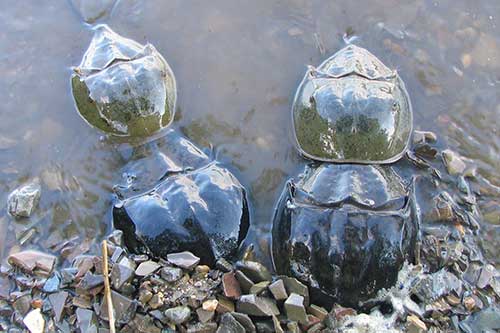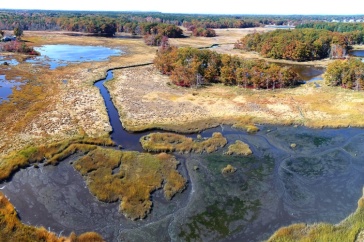
New research from the University of New Hampshire finds that Atlantic horseshoe crabs in New Hampshire’s Great Bay Estuary time their annual spawning based on water temperature, not lunar cycle, as was more commonly believed. The study provides a first-of-its-kind look at the environmental factors that influence horseshoe crab spawning activity in the state and could pave the way for changes in how monitoring surveys are conducted on the East Coast.
“We wanted to establish a baseline for horseshoe crab populations in New Hampshire because it had never been done before,” explained Helen Cheng ’14, who led the research. “Knowing how a species behaves is important in managing their populations, so we needed to know more about horseshoe crab spawning behaviors for effective management.”
A decline in the horseshoe crab population could impact several fields. In medicine, they play an important role in eye research, surgical sutures, and a component of their bright blue blood (LAL) is used in the pharmaceutical industry. American eel and conch fisheries use them for bait and several other species in the ecological food chain depend on them for survival. The preservation of the world’s four remaining horseshoe crab species depends upon proper management of its spawning habitat, which can be challenging due to increased development near beaches.
Each spring, Atlantic horseshoe crabs crawl up on beaches to spawn and lay eggs along the Eastern Seaboard and in N.H.’s Great Bay Estuary,. Little is known about horseshoe crab populations in the Granite State, but spawning surveys are currently conducted in many other states, like neighboring Massachusetts. Rather than collect data for the entire two-month spawning period, many of these surveys take place just during the full and new moons when tides are generally at their most extreme — a protocol that is often based on historical survey practices from other states.

Win Watson, a professor of zoology at UNH and an author on the study, questioned the lunar-based timeframe for surveys and wanted to find out if other environmental factors were at play in causing peaks of spawning activity. Great Bay is an ideal location to study this topic due to the gradual changes in water temperature and salinity from the ocean into the estuary. With help from volunteers, Cheng collected environmental data and counted the number of spawning horseshoe crabs found on four beach areas within the Great Bay Estuary during the spawning season in two consecutive years. They counted more than 5,000 spawning adult horseshoe crabs during that time, and the data revealed that peaks of spawning activity typically coincided with spikes in the bay’s water temperature.
“I think our data is among the best available to show the impact of water temperature on horseshoe crab spawning activity,” said Watson. For example, during one of the sampling years, 2012, there was a particularly warm spring, which caused horseshoe crabs to spawn several weeks earlier than other years.
“We were tracking some of the crabs using telemetry, and as soon as the waters warmed up, they immediately moved several kilometers to where they normally spawn and began the process,” said Watson.
“Horseshoe crabs are a charismatic species and they serve as a great outreach tool to teach the public about the bay and its health.”
The study also examined the influence of other environmental factors including wave height on horseshoe crab spawning activity. Horseshoe crabs orient themselves to the beach based on wave action. When the waves are too small they are unable to find their way to a sandy beach for spawning, and when waves are too large, they avoid the beaches. The research indicated that moderate, one-foot waves, are often associated with peaks in spawning activity.
In the future, the researchers noted that climate change could be a factor that impacts the timing of horseshoe crab spawning. “If water temperatures warm up earlier than usual in the spring, the timing of spawning and egg hatch could occur earlier as well; this could potentially lead to a cascade of unintended consequences affecting horseshoe crab populations and other species that depend on them,” Watson said.
Cheng noted that while conducting daily horseshoe spawning surveys was an arduous task, it provided a more complete perspective on what horseshoe crabs do throughout their spawning season. Based on their findings, both Cheng and Watson said lunar cycle-based spawning surveys in other states could be missing out on some important data.
The researchers hope this study will be used to develop more efficient and effective spawning surveys in Great Bay and beyond. Enthusiastic volunteers have been helpful to start the survey process in N.H. and Watson said a mobile app is being developed to assist with recording data and reporting sightings of horseshoe crabs with tags on them.
Ultimately, Cheng views the horseshoe crab as an ambassador of Great Bay. “Horseshoe crabs are a charismatic species and they serve as a great outreach tool to teach the public about the bay and its health.”
The research, funded in part by N.H. Sea Grant, was published in the journal Estuaries and Coasts.
-
Written By:
Robbin Ray ’82 | UNH Marketing | robbin.ray@unh.edu | 603-862-4864

















































